Qdrant 1.15 - Smarter Quantization & better Text Filtering
Derrick Mwiti
·July 18, 2025

On this page:
Qdrant 1.15.0 is out! Let’s look at the main features for this version:
New quantizations: We introduce asymmetric quantization and 1.5 and 2-bit quantizations. Asymmetric quantization allows vectors and queries to have different quantization algorithms. 1.5 and 2-bit quantizations allow for improved accuracy.
Changes in text index: Introduction of a new multilingual tokenizer, stopwords support, stemming, and phrase matching.
Various optimizations, including HNSW healing, allowing HNSW indexes to reuse the old graph without a complete rebuild, and Migration to Gridstore unlocks faster injestion.
New Quantization Modes

We are expanding the Qdrant quantization toolkit with:
- 1.5-bit and 2-bit quantization for better tradeoffs between compression and accuracy.
- Asymmetric quantization to combine binary storage with scalar queries for smarter memory use.
1.5-Bit and 2-Bit Quantization
We introduce a new binary quantization storage that uses 2 and 1.5 bits per dimension, improving precision for smaller vectors. Previous one-bit compression resulted in significant data loss and precision drops for vectors smaller than a thousand dimensions, often requiring expensive rescoring. 2-bit quantization offers 16X compression compared to 32X with one bit, improving performance for smaller vector dimensions. The 1.5-bit quantization compression offers 24X compression and intermediate accuracy.
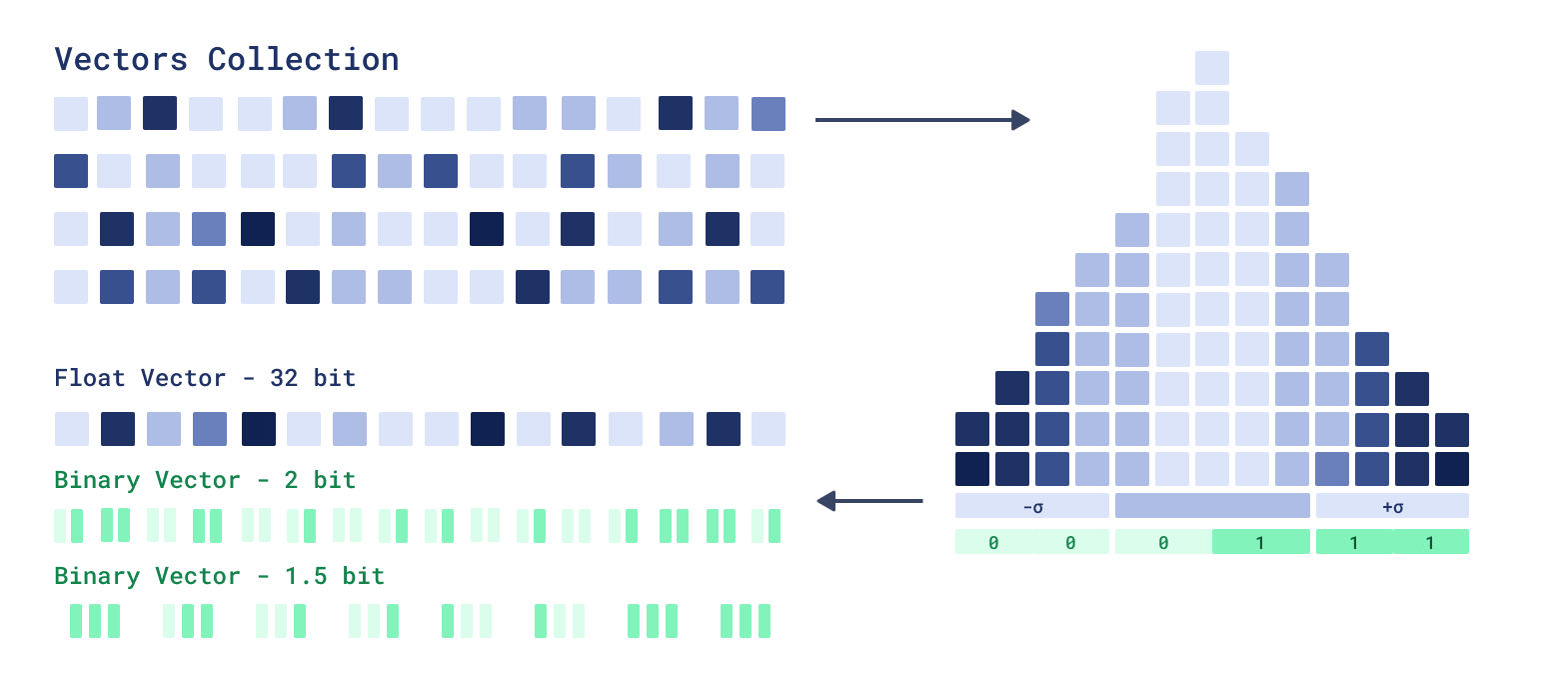
A major limitation of binary quantization is poor handling of values close to zero. 2-bit quantization addresses this by explicitly representing zeros using an efficient scoring mechanism. With 1.5-bit quantization we balance the efficiency of binary quantization with accuracy improvements of 2-bit quantization.
Benchmark Results: 2-bit vs 1-bit and Scalar Quantization
We ran extensive benchmarks to compare the new 2-bit quantization with both traditional 1-bit (binary) quantization and scalar quantization (e.g., 8-bit).
Dataset: Laion 1 million 512d vectors
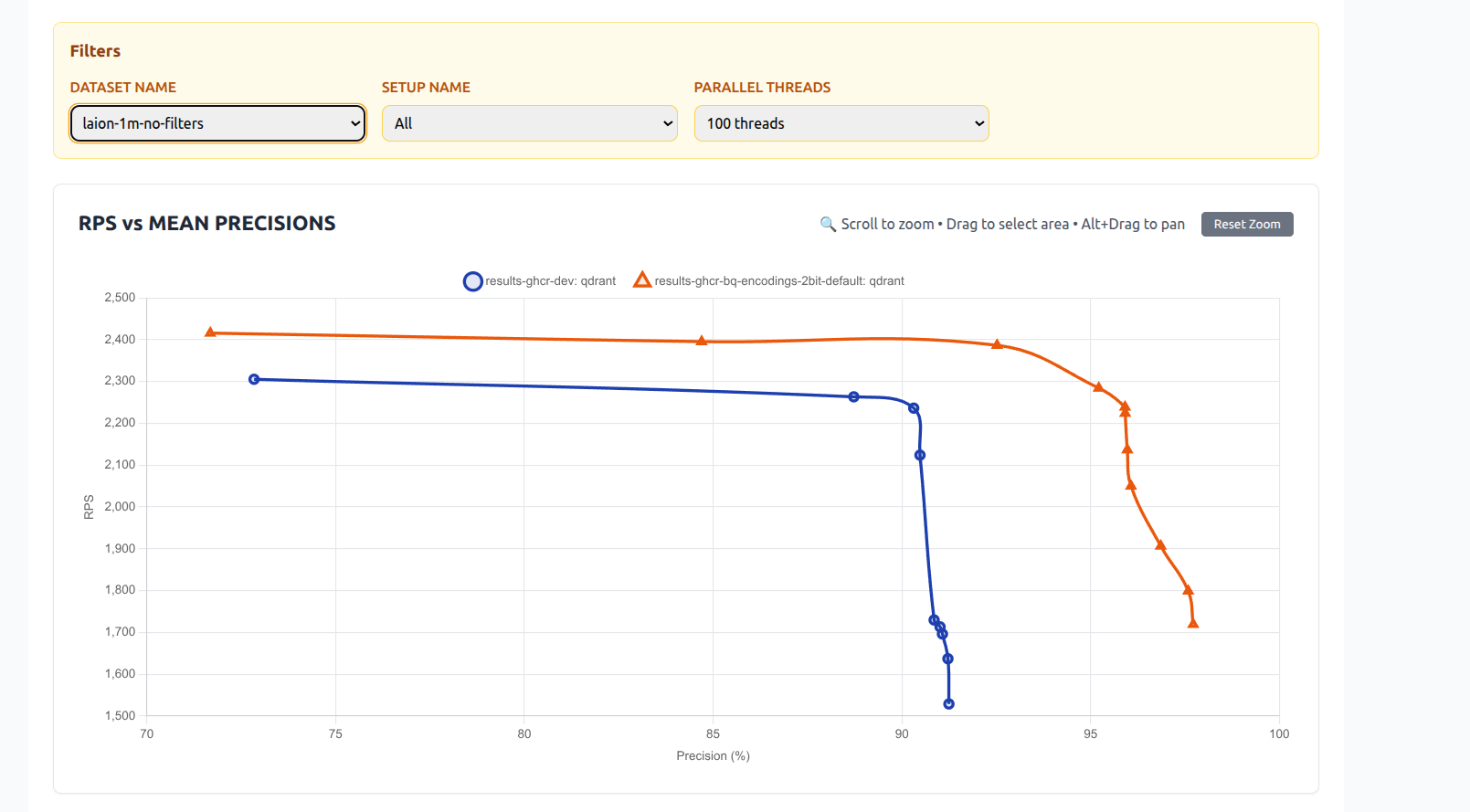
2-bit VS 1-bit Quantization
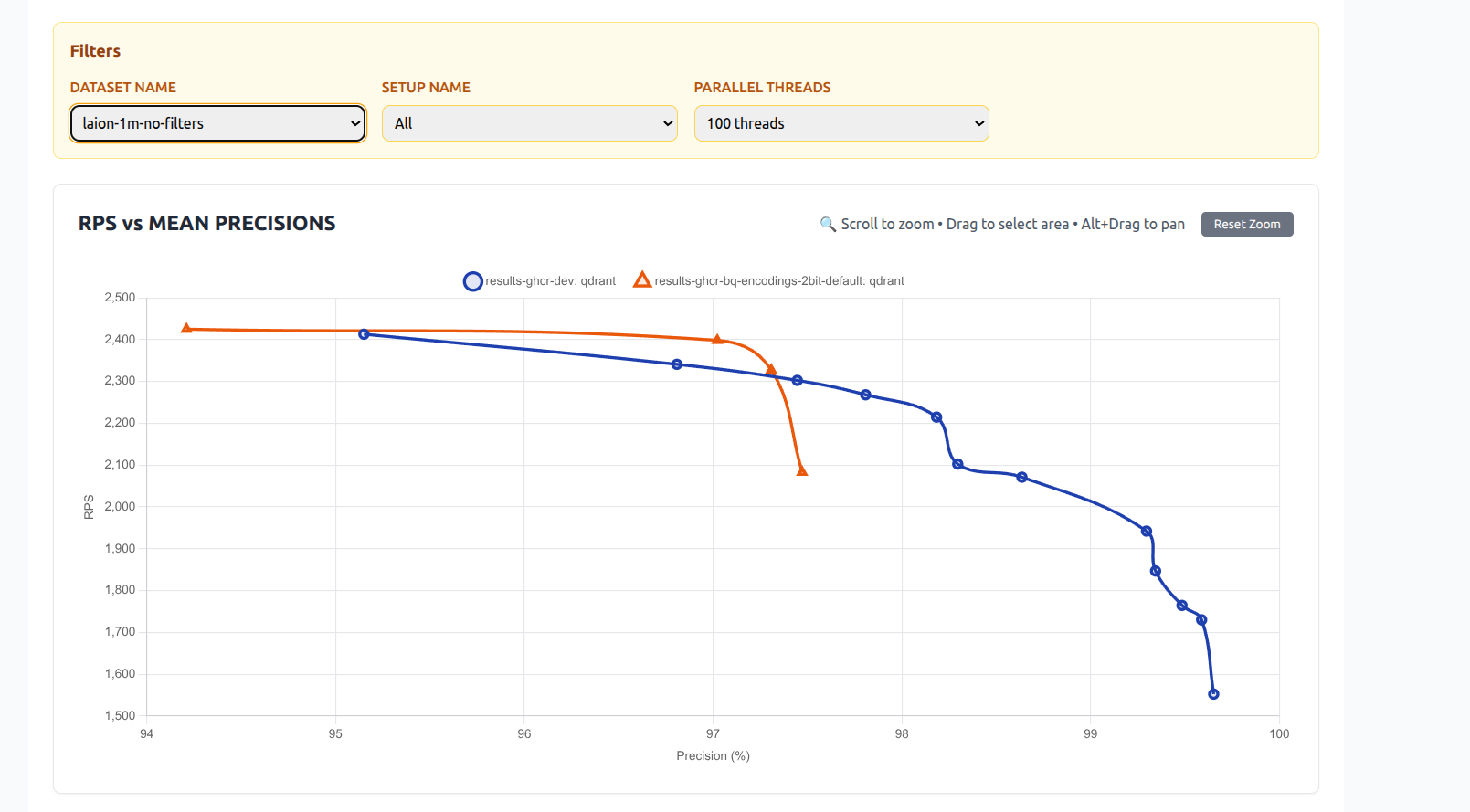
2-bit VS Scalar Quantization
Asymmetric Quantization
The Asymmetric Quantization technique allows qdrant to use different vector encoding algorithm for stored vectors and for queries. Particularly interesting combination is a Binary stored vectors and Scalar quantized queries.
This approach maintains storage size and RAM usage similar to binary quantization while offering improved precision. It is beneficial for memory-constrained deployments, or where the bottleneck is disk I/O rather than CPU. This is particularly useful for indexing millions of vectors as it improves precision without sacrificing much because the limitation in such scenarios is disk speed, not CPU. This approach requires less rescoring for the same quality output.

When performing nearest vector search, the query vector is compared against quantized vectors stored in the database. If the query itself remains unquantized and a scoring method exists to evaluate it directly against the compressed vectors, this allows for more accurate results without increasing memory usage.
Quantization enables efficient storage and search of high-dimensional vectors. Learn more about this from our quantization docs.
Benchmarks result
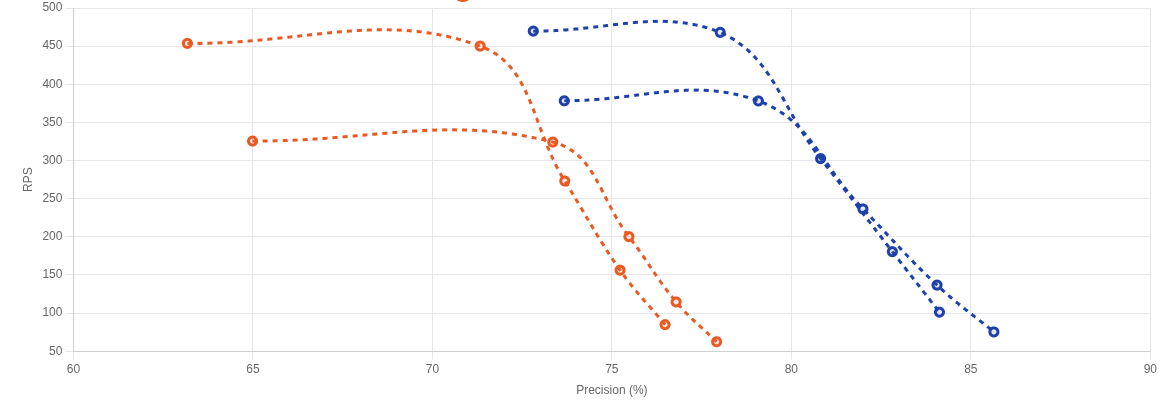
Asymmetric Quantization Benchmark
Blue: Asymmetric 8bit quantization
Orange: Regular Binary Quantization
Dataset: Laion 1 million 512d vectors
Changes in Text Index

Full-text filtering in Qdrant in an efficient way to combine Vector-based scoring with exact keyword match. And in v1.15 full-text index recieved a number of upgrades which make vector similarity evem more useful.
Multilingual Tokenization
Previous versions of Qdrant relied on charabia package to perform multilingual tokenizetion. Unfortunately this package has a significant memory overhead for tokenizers in Korean and Japanese languages, so we could not enable in by default.
With this update you can use a variety of languages in our full-text search index for filters.
This means that languages that don’t have clear word boundaries and aren’t separated by space such as Japanase and Chinese are now natively supported.
Previously, only languages with spaces were supported (with "word" tokenization), or you had to compile Qdrant yourself.
In the new v1.15 release we completely reworked which tokenizer packages are used for specific languages. It allowed us to pack everything in the main build without sacrificing performance.
Qdrant now supports multilingual tokenization, meaning that search will perform more consistently in multilingual datasets without needing external preprocessing.
Here is how to configure the multilingual tokenizer:
PUT /collections/{collection_name}/index
{
"field_name": "description",
"field_index_params": {
"type": "text",
"tokenizer": "multilingual"
}
}
Stop Words
Articles like “a”, conjunctions like “and”, prepostions like “with”, pronouns like “he” and common verbs such as “be”, can clutter your index without adding value to search. Those meaningless works can also complicate construction of filtering condition, when previously you had to manually remove them from the query.
Now you can configure stopwords for qdrant full-text index and Qdrant will handle them automatically.
Here is how to configure stopwords:
PUT /collections/{collection_name}/index
{
"field_name": "title",
"field_index_params": {
"type": "text",
"stopwords": "english"
}
}
For more information about stopwords, see the documentation.
Stemming
Stemming improves text processing by converting words to their root form. For example “run”, “runs”, and “running” will all map to the root “run”. By using stemming you only store the root words, reducing the size of the index and increasing retrieval accuracy.
In Qdrant, stemming allows for better query document matching because grammar-related suffixes that don’t add meaning to words get removed.
We apply stemming in our full-text index increasing recall, because a more variety of queries match the same document.
For example the queries “interesting documentation” and “interested in this document”, will be normalized to ["interest", "document"] and ["interest", "in", "this", "document"], converting them to an overlapping sets.
However, without stemming, these would become ["interesting", "documentation"] and ["interested", "in", "this", "document"], resulting in not a single word matching, despite being very similar in meaning.
Here is an example showing how to configure the collection to use the Snowball stemmer:
PUT /collections/{collection_name}/index
{
"field_name": "body",
"field_index_params": {
"type": "text",
"stemmer": {
"type": "snowball",
"language": "english"
}
}
}
Phrase Matching
With phrase matching, you can now perform exact phrase search. It allows you to search for a specific phrase, words in exact order, within a text field.
For efficient phrase seach Qdrant requires to build an additional data structure, so it needs to be configured during creation of the full-text index:
PUT /collections/{collection_name}/index
{
"field_name": "headline",
"field_index_params": {
"type": "text",
"phrase_matching": true
}
}
For example, the phrase “machine time” will be matched exactly in that order within the “summary” field:
POST /collections/{collection_name}/points/query
{
"vector": [0.01, 0.45, 0.67, 0.12],
"filter": {
"must": {
"key": "summary",
"match": {
"phrase": "machine time"
}
}
},
"limit": 10
}
The above will match:
| text | |
|---|---|
| ✅ | “The machine time is local, rather than global in distributed systems.” |
| ❌ | “Dr. Brown retrofitted a DeLorean into a time machine.” |
MMR Reranking
We introduce Maximal Marginal Relevance (MMR) reranking to balance relevance and diversity. MMR works by selecting the results iteratively, by picking the item with the best combination of similarity to the query and dissimilarity to the already selected items.
It prevents your top-k results from being redundant and helps surface varied but relevant answers, particularly in dense datasets with overlapping entries.
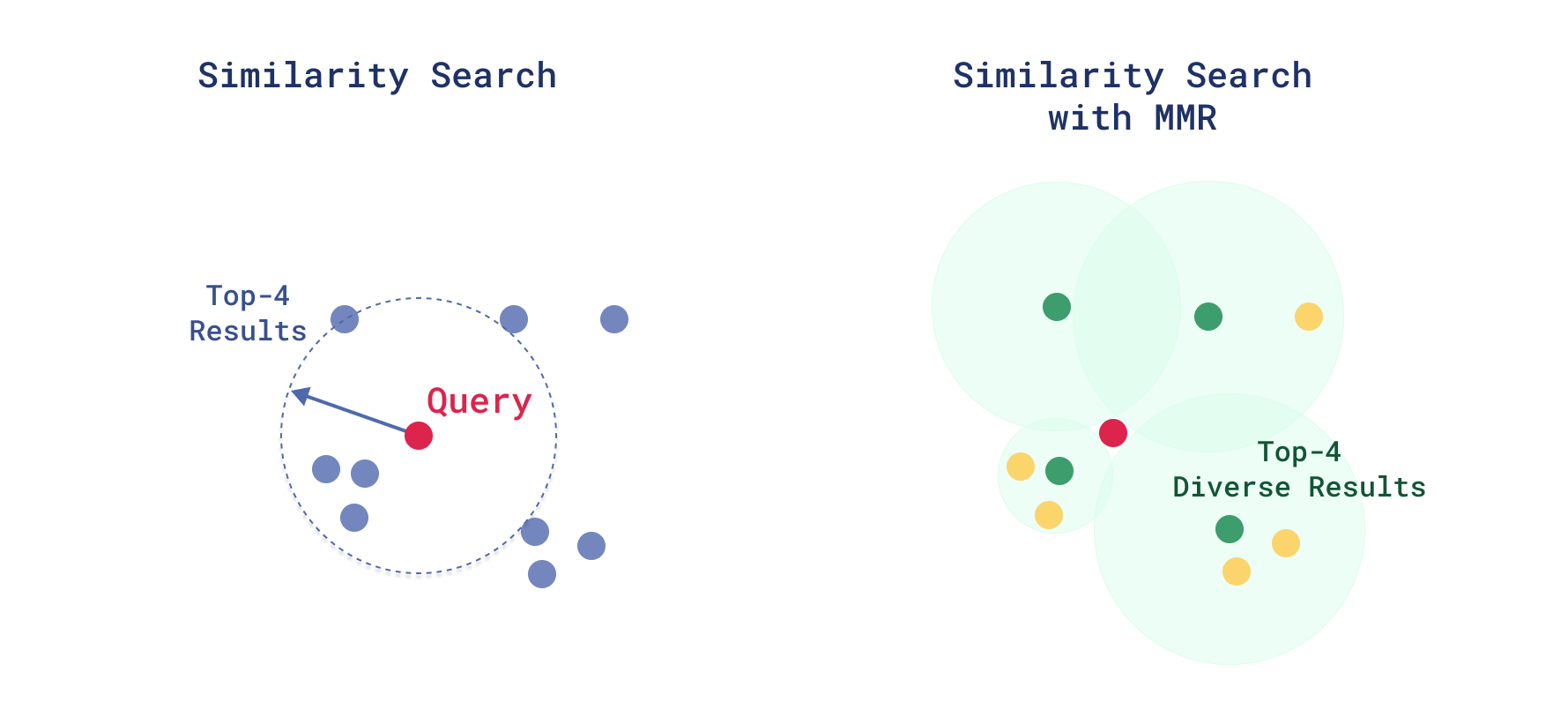
Diversifying Search Results with MMR
Let’s say you’re building a knowledge assistant or semantic document explorer in which a single query can return multiple highly similar queries. For instance, searching “climate change” in a scientific paper database might return several similar paragraphs.
You can diversify the results with Maximal Marginal Relevance (MMR).
Instead of returning the top-k results based on pure similarity, MMR helps select a diverse subset of high-quality results. This gives more coverage and avoids redundant results, which is helpful in dense content domains such as academic papers, product catalogs, or search assistants.
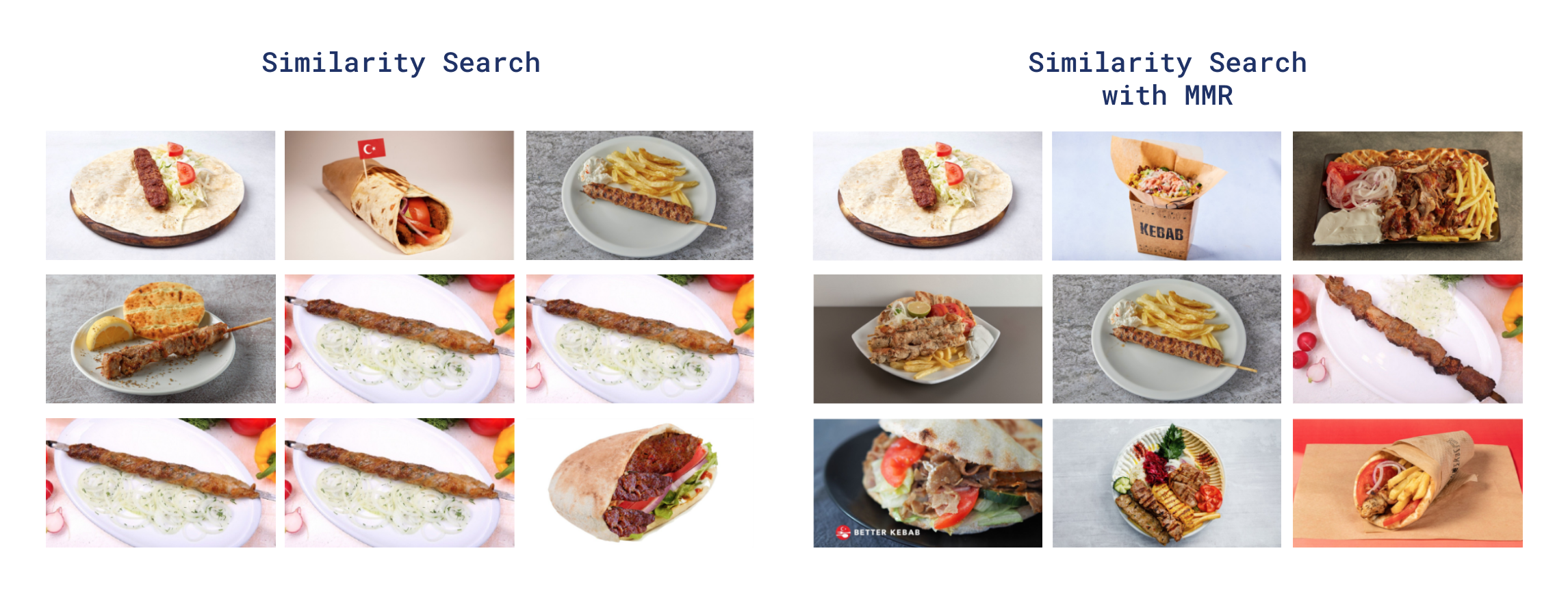
For example, you have vectorized paragraphs from hundreds of documents and stored them in Qdrant. Instead of showing only five nearly identical answers, you want your chatbot to respond with diverse answers. Here’s how to do it:
POST /collections/{collection_name}/points/query
{
"query": {
"nearest": [0.01, 0.45, 0.67, ...], // search vector
"mmr": {
"diversity": 0.5, // 0.0 - relevance; 1.0 - diversity
"candidates_limit": 100 // num of candidates to preselect
}
},
"limit": 10
}
Migration to Gridstore

When we started building Qdrant, we picked RocksDB as our embedded key-value store. However, due to it’s architecture we ran into issues such as random latency spikes. Gridstore is our custom solution to this and other challenges we faced when building with RocksDB. Qdrant 1.15 continues our transition from RocksDB to Gridstore as the default storage backend for new deployments, leading to:
- Faster ingestion speeds.
- Storage management without “garbage collection”.
For more insights on the performance of Gridstore compared to RocksDB checkout our Introducing Gridstore article.
Optimizations
As usual, new Qdrant release brings more performance optimization for faster and cheaper vector search at scale.
HNSW Healing
Qdrant 1.15 introduces HNSW healing.
Instead of completely re-building HNSW index during optimization, Qdrant now tries to re-use information from the existing vector index to speed-up construction of the new one. When points are removed from an existing HNSW graph, new links are added to prevent isolation in the graph, and avoid decreasing search quality.

Indexing speed with healing vs full re-index
This modification, in combinations with incremental HNSW indexing introduced in v1.14.0, it significantly improves resource utilization in use-case with high update rates.
HNSW Graph connectivity estimation
Qdrant builds addtitional HNSW links to ensure that filtered searches are performed fast and accurate.
It does, however, introduce an overhead for indexing complexity, especially when the number of payload indexes is large. With v1.15, Qdrant introduces an optimization, which quickly estimates graph connectivity before creating additional links.
Is some scenarios this optimization can reduce indexation time multiple times without sacrificing search quality.

Changes in Web UI
Main Web-UI feature of the release is a Create Collection dialog.
This dialog is designed with an idea to guide users through the configuration process. Instead of listing all possible configurations, we tried to organise it into an intuitive flow that also encourages best-practices.
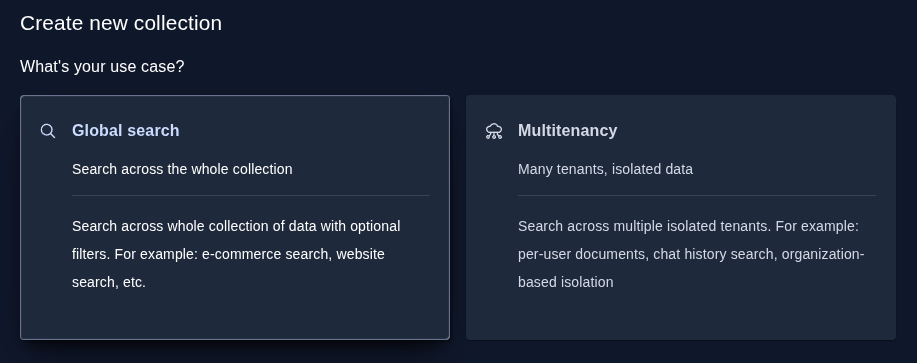
Upgrading to Version 1.15
In Qdrant Cloud, simply go to your Cluster Details screen and select Version 1.15 from the dropdown. The upgrade may take a few moments.
Upgrading from earlier versions is straightforward - no major API or index-breaking changes. We recommend upgrading versions one by one, for example, 1.13 ->1.14->1.15.

Updating to the latest software version from the Qdrant Cloud dashboard
Documentation: For detailed usage examples, configuration options, and implementation guides, including quantization, MMR rescoring, multilingual text indexing, and more, refer to the official Qdrant documentation and API reference. You’ll find full code samples, integration walkthroughs, and best practices for building high-performance vector search applications.
Engage

We would love to hear your thoughts on this release. If you have any questions or feedback, join our Discord or create an issue on GitHub.

































